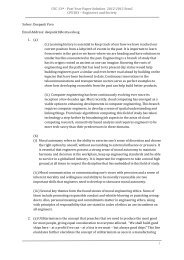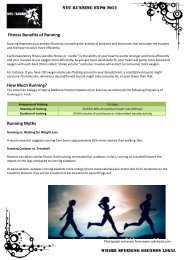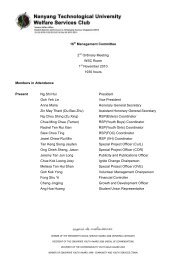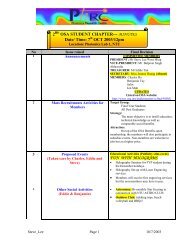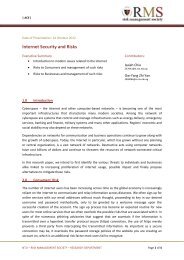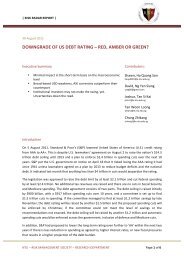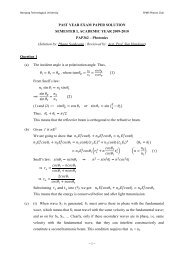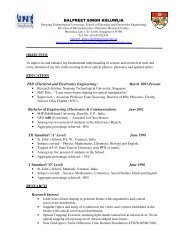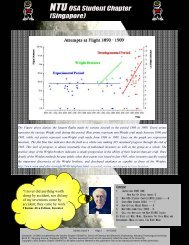AIG, Credit Default Swaps and the Financial Crisis
AIG, Credit Default Swaps and the Financial Crisis
AIG, Credit Default Swaps and the Financial Crisis
Create successful ePaper yourself
Turn your PDF publications into a flip-book with our unique Google optimized e-Paper software.
| RISK RADAR REPORT |<br />
The apparently imminent mortgage crisis, coupled with <strong>AIG</strong>’s excessive exposure to CDS on MBS,<br />
triggered rating agencies like Moody’s to lower its credit rating. Consequently, <strong>AIG</strong> suffered a<br />
liquidity crunch <strong>and</strong> was pushed to <strong>the</strong> verge of bankruptcy. Of course, <strong>AIG</strong>’s systemically important<br />
financial institution (SIFI) status meant that it was eventually bailed out by <strong>the</strong> Federal Reserve.<br />
2.0 Impacts of crisis on <strong>AIG</strong><br />
Liquidity crunch<br />
When <strong>the</strong> housing market crashed <strong>and</strong> subprime mortgage borrowers defaulted, <strong>the</strong> value of MBS<br />
fell drastically. At that point in time, <strong>AIG</strong> insured more than $440 billion of fixed income investments<br />
held by <strong>the</strong> world’s leading financial institutions, including $57.8 billion in paper related to subprime<br />
mortgages (White & Moreira, 2008). Investors of MBS who had bought CDS protection also sought<br />
insurance payout from <strong>AIG</strong> simultaneously. These events, coupled with increased collateral<br />
requirements due to <strong>the</strong> downgrade of its credit ratings by major rating agencies, eventually caused<br />
<strong>AIG</strong> to suffer a liquidity crunch. It did not have enough cash <strong>and</strong> o<strong>the</strong>r liquid assets to meet its<br />
current obligations.<br />
Severely damaged reputation<br />
Before its fall from grace, <strong>AIG</strong> was <strong>the</strong> biggest <strong>and</strong> most well-known br<strong>and</strong> name in <strong>the</strong> industry to<br />
<strong>the</strong> extent that it was an icon of <strong>the</strong> insurance market throughout <strong>the</strong> world (Crump, 2008).<br />
The $180 billion bailout of <strong>AIG</strong>, however, was one of <strong>the</strong> least popular in history (Irwin, 2013), <strong>and</strong><br />
resulted in US public resentment towards <strong>AIG</strong>. The majority of <strong>the</strong> public had reservations about <strong>the</strong><br />
appropriateness for <strong>the</strong> government to use taxpayers’ money to aid an ailing institution.<br />
Fur<strong>the</strong>rmore, <strong>the</strong>re was uproar when some of <strong>the</strong>se supposed funds which were channelled to see<br />
<strong>AIG</strong> through <strong>the</strong> stormy season were instead used to disburse bonuses to <strong>AIG</strong>’s officials.<br />
Unlike <strong>the</strong> capital of a company, reputation lost is difficult to recover, <strong>and</strong> <strong>AIG</strong>’s recent unexpected<br />
lawsuit against <strong>the</strong> US government made <strong>the</strong> task of restoring its popularity an even more<br />
challenging one.<br />
3.0 Underlying causes of <strong>the</strong> problems experienced by <strong>AIG</strong><br />
3.1 Intensive writing of CDS by <strong>AIG</strong> <strong>Financial</strong> Products (<strong>AIG</strong>FP)<br />
To begin this section, we shall first be introduced to a subsidiary of <strong>AIG</strong>, <strong>the</strong> <strong>AIG</strong> <strong>Financial</strong> Products<br />
(<strong>AIG</strong>FP). <strong>AIG</strong>FP was set up in 1987 to manage innovative financial products, with a focus on<br />
OTC derivatives markets, outside <strong>the</strong> insurance industry (Baranoff, 2012).<br />
During <strong>the</strong> bullish run-up to <strong>the</strong> mortgage bubble burst, banks <strong>and</strong> financial institutions were on a<br />
roll, furiously writing MBS, distributing <strong>and</strong> collecting fees from tranches. With almost willing<br />
compliance, insurers like <strong>AIG</strong>FP, on <strong>the</strong> o<strong>the</strong>r h<strong>and</strong>, were furiously writing <strong>Credit</strong> <strong>Default</strong> <strong>Swaps</strong> to<br />
cover <strong>the</strong> MBS <strong>and</strong> collecting h<strong>and</strong>some premiums in return from <strong>the</strong> MBS writers. Back <strong>the</strong>n, <strong>AIG</strong>FP<br />
had an exposure to about $440 billion in CDS.<br />
NTU – RISK MANAGEMENT SOCIETY – RESEARCH DEPARTMENT Page 4 of 12




